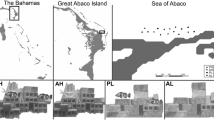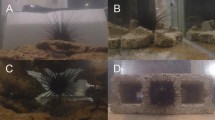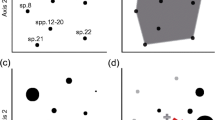Abstract
Greater structural complexity is often associated with greater abundance and diversity, perhaps because high complexity habitats reduce predation and competition. Using 16 spatially isolated live-coral reefs in the Bahamas, I examined how abundance of juvenile (recruit) and adult (non-recruit) fishes was affected by two factors: (1) structural habitat complexity and (2) the presence of predators and interference competitors. Manipulating the abundance of low and high complexity corals created two levels of habitat complexity, which was cross-factored with the presence or absence of resident predators (sea basses and moray eels) plus interference competitors (territorial damselfishes). Over 60 days, predators and competitors greatly reduced recruit abundance regardless of habitat complexity, but did not affect adult abundance. In contrast, increased habitat complexity had a strong positive effect on adult abundance and a weak positive effect on recruit abundance. Differential responses of recruits and adults may be related to the differential effects of habitat complexity on their primary predators. Sedentary recruits are likely most preyed upon by small resident predators that ambush prey, while larger adult fishes that forage widely and use reefs primarily for shelter are likely most preyed upon by large transient predators that chase prey. Increased habitat complexity may have inhibited foraging by transient predators but not resident predators. Results demonstrate the importance of habitat complexity to community dynamics, which is of concern given the accelerated degradation of habitats worldwide.



Similar content being viewed by others
References
Almany GR (2003) Priority effects in coral reef fish communities. Ecology 84:1920–1935
Almany GR (2004) Does increased habitat complexity reduce predation and competition in coral reef fish assemblages? Oikos (in press)
Ault TR, Johnson CR (1998) Relationships between habitat and recruitment of three species of damselfish (Pomacentridae) at Heron Reef, Great Barrier Reef. J Exp Mar Biol Ecol 223:145–166
Babbitt KJ, Tanner GW (1998) Effects of cover and predator size on survival and development of Rana utricularia tadpoles. Oecologia 114:258–262
Bell SS, McCoy ED, Mushinsky HR (eds) (1991) Habitat structure: the physical arrangement of objects in space. Chapman and Hall, London
Beukers JS, Jones GP (1997) Habitat complexity modifies the impact of piscivores on a coral reef fish population. Oecologia 114:50–59
Booth DJ (1992) Larval settlement patterns and preferences by domino damselfish Dascyllus albisella Gill. J Exp Mar Biol Ecol 155:85–104
Buchheim JR, Hixon MA (1992) Competition for shelter holes in the coral-reef fish Acanthemblemaria spinosa Metzelaar. J Exp Mar Biol Ecol 164:45–54
Caley MJ, St. John J (1996) Refuge availability structures assemblages of tropical reef fishes. J Anim Ecol 65:414–428
Carr MH, Hixon MA (1995) Predation effects on early post-settlement survivorship of coral-reef fishes. Mar Ecol Prog Ser 124:31–42
Chapman MR, Kramer DL (2000) Movements of fishes within and among fringing coral reefs in Barbados. Environ Biol Fish 57:11–24
Dahlgren CP, Eggleston DB (2000) Ecological processes underlying ontogenetic habitat shifts in a coral reef fish. Ecology 81:2227–2240
Danilowicz BS (1996) Choice of coral species by naive and field-caught damselfish. Copeia 1996:735–739
Dickman CR (1992) Predation and habitat shift in the house mouse, Mus domesticus. Ecology 73:313–322
Doherty PJ (1982) Some effects of density on the juveniles of two species of tropical, territorial damselfishes. J Exp Mar Biol Ecol 65:249–261
Eklöv P, Diehl S (1994) Piscivore efficiency and refuging prey: the importance of predator search mode. Oecologia 98:344–353
Emery AR (1973) Comparative ecology and functional osteology of fourteen species of damselfish (Pisces: Pomacentridae) at Alligator Reef, Florida Keys. Bull Mar Sci 23:649–770
Flynn AJ, Ritz DA (1999) Effect of habitat complexity and predatory style on the capture success of fish feeding on aggregated prey. J Mar Biol Assoc UK 79:487–494
Frederick JL (1997) Post-settlement movement of coral reef fishes and bias in survival estimates. Mar Ecol Prog Ser 150:65–74
Gladfelter WB, Johnson WS (1983) Feeding niche separation in a guild of tropical reef fishes (Holocentridae). Ecology 64:552–563
Hixon MA (1991) Predation as a process structuring coral reef fish communities. In: Sale PF (ed) The ecology of fishes on coral reefs. Academic, San Diego, pp 475–508
Hixon MA, Beets JP (1989) Shelter characteristics and Caribbean fish assemblages: experiments with artificial reefs. Bull Mar Sci 44:666–680
Hixon MA, Beets JP (1993) Predation, prey refuges, and the structure of coral-reef fish assemblages. Ecol Monogr 63:77–101
Hixon MA, Carr MH (1997) Synergistic predation, density dependence, and population regulation in marine fish. Science 277:946–949
Hixon MA, Menge BA (1991) Species diversity: prey refuges modify the interactive effects of predation and competition. Theor Popul Biol 39:178–200
Hixon MA, Webster MS (2002) Density dependence in reef fish populations. In: Sale PF (ed) Coral reef fishes: dynamics and diversity in a complex ecosystem. Academic, San Diego, pp 303–325
Holbrook SJ, Schmitt RJ (1988) The combined effects of predation risk and food reward on patch selection. Ecology 69:125–134
Holbrook SJ, Schmitt RJ (2002) Competition for shelter space causes density-dependent predation mortality in damselfishes. Ecology 83:2855–2868
Jones GP, Syms C (1998) Disturbance, habitat structure and the ecology of fishes on coral reefs. Aust J Ecol 23:287–297
Kramer DL, Chapman MR (1999) Implications of fish home range size and relocation for marine reserve function. Environ Biol Fish 55:65–79
Lewis AR (1997) Recruitment and post-recruit immigration affect the local population size of coral reef fishes. Coral Reefs 16:139–149
Lirman D (1994) Ontogenetic shifts in habitat preference in the three-spot damselfish, Stegastes planifrons (Cuvier), in Roatan Island, Honduras. J Exp Mar Biol Ecol 180:71–81
MacArthur RH, Levins R (1967) The limiting similarity, convergence, and divergence of coexisting species. Am Nat 101:377–385
Mcafee ST, Morgan SG (1996) Resource use by five sympatric parrotfishes in the San Blas Archipelago, Panama. Mar Biol 125:427–437
McCormick MI (1994) Comparison of field methods for measuring surface topography and their associations with a tropical reef fish assemblage. Mar Ecol Prog Ser 112:87–96
McCormick MI, Makey LJ (1997) Post-settlement transition in coral reef fishes: overlooked complexity in niche shifts. Mar Ecol Prog Ser 153:247–257
McCormick MI, Makey L, Dufour V (2002) Comparative study of metamorphosis in tropical reef fishes. Mar Biol 141:841–853
Munday PL, Jones GP (1998) The ecological implications of small body size among coral-reef fishes. Oceanogr Mar Biol Annu Rev 36:373–411
Murdoch WW, Oaten A (1975) Predation and population stability. Adv Ecol Res 9:1–132
Ohman MC, Munday PL, Jones GP, Caley MJ (1998) Settlement strategies and distribution patterns of coral-reef fishes. J Exp Mar Biol Ecol 225:219–238
Parrish JD, Zimmerman RJ (1977) Utilization by fishes of space and food resources on an off-shore Puerto Rican coral reef and its surroundings. Proc Third Int Coral Reef Symp 1:297–303
Pierce CL (1988) Predator avoidance, microhabitat shift, and risk-sensitive foraging in larval dragonflies. Oecologia 77:81–90
Randall JE (1965) Grazing effects on seagrasses by herbivorous reef fishes in the West Indies. Ecology 46:255–260
Randall JE (1967) Food habits of reef fishes of the West Indies. Stud Trop Oceanogr 5:665–847
Risk MJ (1972) Fish diversity on a coral reef in the Virgin Islands. Atoll Res Bull 153:1–6
Roberts CM, Ormond RFG (1987) Habitat complexity and coral reef fish diversity and abundance on Red Sea fringing reefs. Mar Ecol Prog Ser 41:1–8
Robertson DR (1996) Interspecific competition controls abundance and habitat use of territorial Caribbean damselfishes. Ecology 77:885–899
SAS Institute (2000) JMP user’s guide, version 4. SAS Institute, Cary, N.C.
Schneider KJ (1984) Dominance, predation and optimal foraging in white-throated sparrow flocks. Ecology 65:1820–1827
Shulman MJ (1984) Resource limitation and recruitment patterns in a coral reef fish assemblage. J Exp Mar Biol Ecol 74:85–109
Shulman MJ (1985a) Coral reef fish assemblages: intra- and interspecific competition for shelter sites. Environ Biol Fish 13:81–92
Shulman MJ (1985b) Recruitment of coral reef fishes: effects of distribution of predators and shelter. Ecology 66:1056–1066
Sih A, Kats LB, Moore RD (1992) Effects of a predatory sunfish on the density, drift, and refuge use of stream salamander larvae. Ecology 73:1418–1430
Sokal RR, Rohlf FJ (eds) (1995) Biometry, 3rd edn. Freeman, New York
Thorrold SR, Shenker JM, Maddox ED, Mojica R, Wishinski E (1994) Temporal patterns in the larval supply of summer-recruiting reef fishes to Lee Stocking Island, Bahamas. Mar Ecol Prog Ser 112:75–86
Webster MS (2002) Role of predators in the early post-settlement demography of coral-reef fishes. Oecologia 131:52–60
Webster MS, Almany GR (2002) Positive indirect effects in a coral reef fish community. Ecol Lett 5:549–557
Werner EE, Gilliam JF (1984) The ontogenetic niche and species interactions in size-structured populations. Annu Rev Ecol Syst 15:393–425
Werner EE, Hall DJ (1988) Ontogenetic habitat shifts in bluegill: the foraging rate-predation risk trade-off. Ecology 69:1352–1366
Werner EE, Gilliam JF, Hall DJ, Mittelbach GG (1983) An experimental test of the effects of predation risk on habitat use in fish. Ecology 64:1540–1548
Zar JH (1999) Biostatistical analysis, 4th edn. Simon and Schuster, Upper Saddle River, N.J.
Zeller DC (1997) Home range and activity patterns of the coral trout Plectropomus leopardus (Serranidae). Mar Ecol Prog Ser 154:65–77
Acknowledgements
I am especially grateful to J. Almany, K. Overholtzer, D. Piechnik, and M. Webster for assistance and advice in the field. Financial support was provided by an NSF Graduate Predoctoral Fellowship and International Research Fellowship, a Fulbright Postgraduate Award, and NSF grants (OCE-96-17483 and OCE-00-93976) and NOAA-NURP grants (CMRC-95-3042 and CMRC-97-3109) to M. Hixon. This manuscript benefited from reviews by my graduate committee: M. Hixon (chair), P. Bayley, M. Carr, B. Menge, and S. Sogard. Additional reviews were provided by M. McCormick, P. Munday, M. Webster and two anonymous reviewers.
Author information
Authors and Affiliations
Corresponding author
Appendix
Appendix
Families and species included in each category of fishes
Family and species | Recruits | Adults |
|---|---|---|
Acanthuridae (surgeonfishes) | ||
Acanthurus bahianus | X | X |
A. coeruleus | X | X |
A. chirurgus | X | |
Chaetodontidae (butterflyfishes) | ||
Chaetodon aculeatus | X | |
C. ocellatus | X | X |
C. sedentarius | X | |
C. striatus | X | |
Gobiidae (gobies) | ||
Coryphopterus dicrus | X | |
C. glaucofraenum | X | |
Gnatholepis thompsoni | X | |
Haemulidae (grunts) | ||
Haemulon album | X | |
H. flavolineatum | X | |
H. melanurum | X | |
H. plumieri | X | |
Holocentridae (squirrelfishes) | ||
Holocentrus adscensionis | X | |
H. bullisi | X | |
H. coruscus | X | |
Labridae (wrasse) | ||
Halichoeres garnoti | X | X |
H. maculipinna | X | X |
H. pictus | X | |
H. radiatus | X | X |
Thalassoma bifasciatum | X | X |
Labrisomidae | ||
Malacoctenus macropus | X | |
M. triangulates | X | |
Mullidae (goatfishes) | ||
Pseudopeneus maculatus | X | |
Pomacanthidae (angelfishes) | ||
Centropyge argi | X | |
Holacanthus ciliaris | X | X |
H. tricolor | X | X |
Pomacanthus arcuatus | X | X |
Pomacentridae (damselfishes) | ||
Chromis cyanea | X | |
Stegastes leucostictus | X | |
S. partitus | X | |
S. variabilis | X | |
Scaridae (parrotfishes) | ||
Cryptotomus roseus | X | |
Scarus coeruleus | X | |
Sparisoma atomarium | X | |
S. aurofrenatum | X | |
S. chrysopterum | X | |
S. viride | X | |
Rights and permissions
About this article
Cite this article
Almany, G.R. Differential effects of habitat complexity, predators and competitors on abundance of juvenile and adult coral reef fishes. Oecologia 141, 105–113 (2004). https://doi.org/10.1007/s00442-004-1617-0
Received:
Accepted:
Published:
Issue Date:
DOI: https://doi.org/10.1007/s00442-004-1617-0




